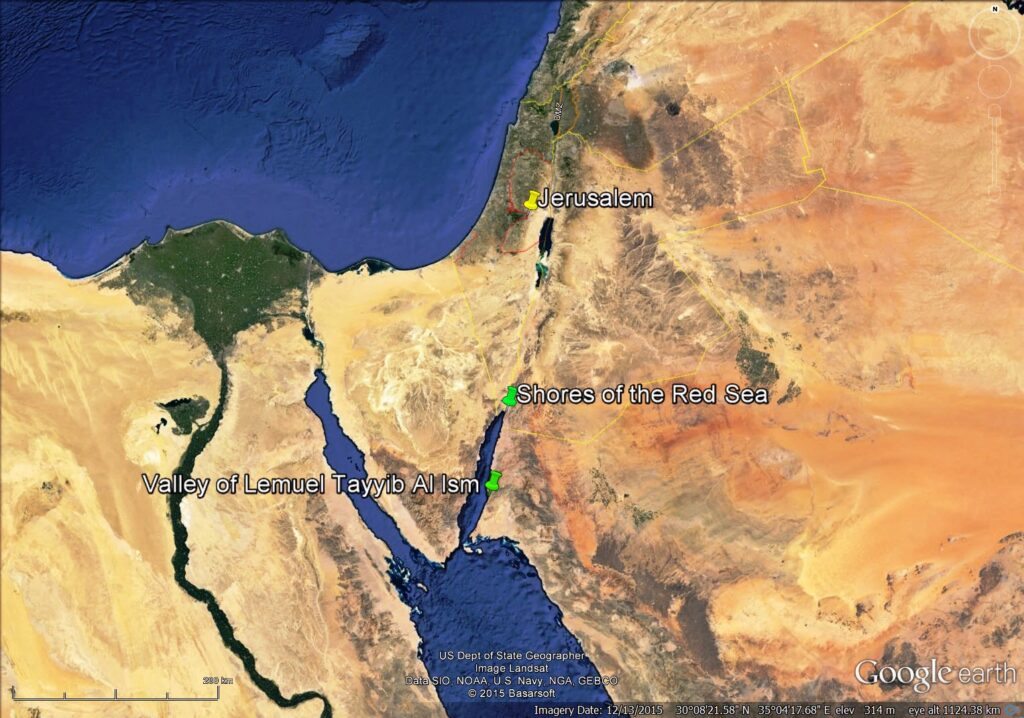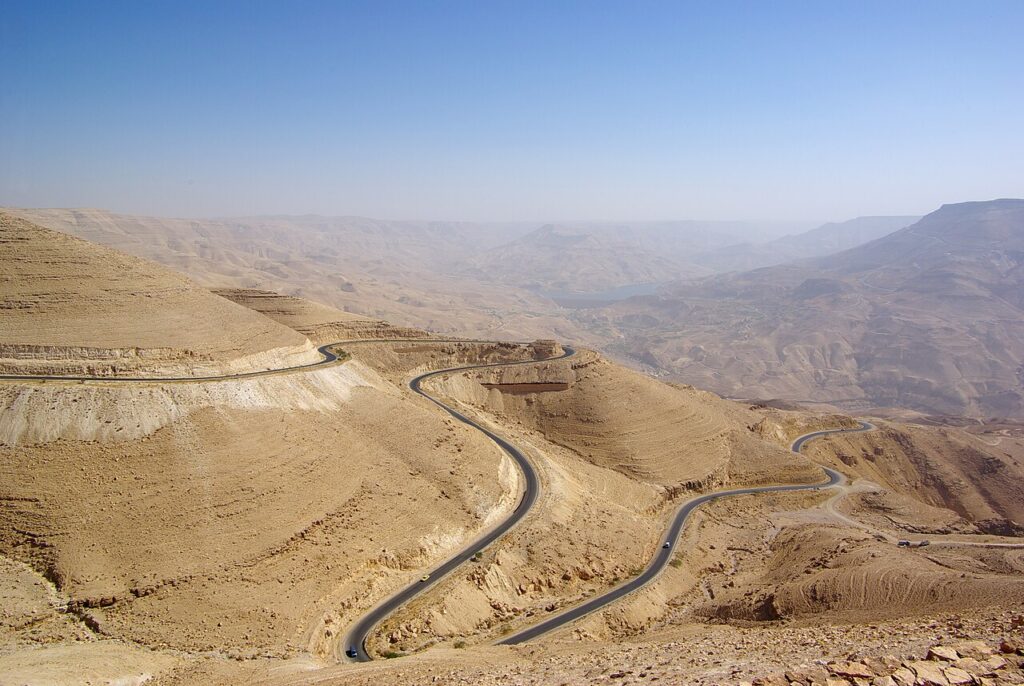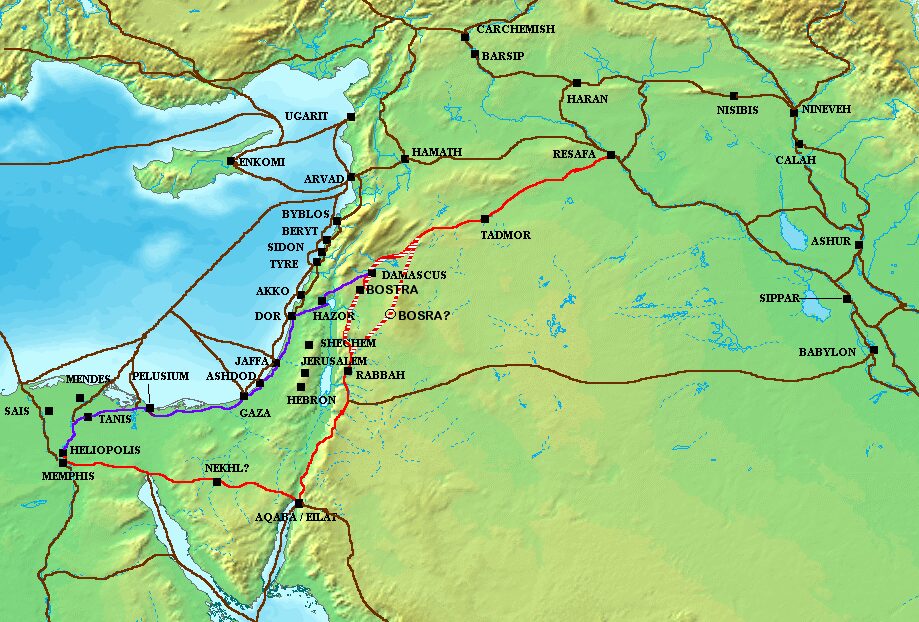
I dated a girl in high school who had a Jewish stepfather and a born again Christian mother. She introduced me to anti-Mormon literature. I can’t recall the name of the short book she (her mother) gave me, but I recall feeling very dark after reading it.
One of the arguments the book made was that there was no river that emptied into the Red Sea.
I’m grateful that my dad, who was a convert from Virginia, was able to refute many of the claims this book made. But at the time, in 1986, many people believed that there really was NOT a river along Lehi’s route that would have emptied into the Red Sea. Most maps back then would have supported that anti-Mormon argument.
As recently at 2012, some still argued that there simply is not such a river. Many people even today support that argument, despite new evidence.
At the time I think my dad gave a great apologetics answer that the river could have simply dried up. But, Lehi did say: “I wish you would be like this river — always flowing into the source of all righteousness” (1 Nephi 2:7 RE). Always flowing…
Recently I dug into this topic a little further and I discovered that there IS a river that flows into the Red Sea. It’s called the Wadi Tayyib Al Ism. And interestingly, it’s located exactly 3 days journey from the tip of the Borders of the Red Sea — the distance mentioned in the Book of Mormon.
He came down by the mountains near the Red Sea shore, journeying through the wilderness until reaching the Borders of the Red Sea. He traveled with his family, consisting of my mother Sariah, and older brothers, who were Laman, Lemuel, and Sam. After he traveled for three days across the wilderness, he pitched his tent in a valley by a river (1 Nephi 2:5 RE).
The Borders of the Red Sea would be called Aqaba today, the northeastern inlet to the Red Sea.
Also very interesting, the location of this river and the Valley Lehi named Lemuel, is very close to the location many believe Moses crossed the Red Sea in leaving Egypt.
To get to the Red Sea, Lehi and his family likely traveled on the King’s Highway which is pictured below which as you can see is very mountainous as Nephi (Joseph Smith) describes.

The King’s Highway was an ancient trade and military route that began, in the north, at Damascus.
In a region so wild and mountainous, surely Lehi and his family would have traveled on a road, or at least near it, to navigate successfully through that barren wasteland.
It’s also no wonder that when they arrived at the the River Laman (Wadi Tayyib Al Ism), they would have finally been able to rest and feel less threatened. They would have had living water, a “firm valley” and they would have no longer been on a highway that was a well traveled trade route before the time of Abraham, through the reigns of David and Solomon and beyond.
King’s Highway is in red in the map below.

Lehi’s family stayed in the Valley of Lemuel for many months. It was there that the Lord commanded Lehi to send his sons back to Jerusalem to obtain the plates. They built an altar in the Valley of Lemuel upon arriving and they offered sacrifices to the Lord on that altar when Lehi’s sons arrived from Jerusalem with Laban’s plates and with Ishmael’s family on their second trip.
It was in this valley that Lehi had his dream or vision of the Tree of Life. It was here that Nephi also communed with heaven and also beheld his father’s vision.
It’s worth noting that a journey back to Jerusalem would have taken Nephi and his brothers 30 days, walking 8 hours a day. Even if they had camels, it would require at least one month if not longer to make the journey.
No wonder Sariah was so panicked! Her and Lehi’s faith was truly tested. They had sent, after all, their young sons who were their only real chance at surviving their journey. The River Laman contained no fish. Foraging for food would have been difficult but would have provided some food. Small game would have been their source of food along with the provisions they would have had with them.
When they finally made it back to the Valley of Lemuel, after “murdering Laban” and having “stolen” the Brass Plates from the Treasury, Sariah was able to now say unequivocally:
Now I know for sure the Lord has commanded my husband to escape into the wilderness. I also know for certain the Lord has protected my sons and rescued them from Laban and given them power so they were able to accomplish what He had commanded them to do (1 Nephi 5:8 RE).
Sariah now knew God was with them. And with her husband, the Visionary Man.
Imagine, your only true source of survival, your only begotten sons, all 4 of them, being gone for no less than 120 days! While you and your dreaming husband are camping near the Red Sea, in the wilderness, after fleeing your home, your wealth — in fear of your life — as the Jewish Church and government were searching for you and trying to kill you.
As I re-read this story recently, I wondered why Lehi would name this river and this valley Laman and Lemuel, respectively. Had those things not already been named? Why rename them? Or why name them at all?
I discovered in my study that the name Laman in Hebrew means “desire” or “wish” or “why or for what reason.” Surely Sariah at a minimum wondered “why” they had been commanded to leave her homeland. So maybe the river Laman is the “why”…
The name Lemuel in Hebrew is translated as “belonging to God.”
In Lehi’s dream, in the Valley of Lemuel, the family learned who belonged to God: namely Lehi, Sariah, Nephi and Sam.
I imagine that Nephi, through his own experiences in that Valley, also learned for himself that his course pleased God and that he “belonged to Him.”
I love the Book of Mormon. We learn in the very second chapter what made the difference for Nephi. We learn how he was different from his brothers.
Since I was very young–but large in build–and had a strong desire to know God’s mysteries, I cried to the lord in prayer. He influenced me and softened my heart letting me believe everything my father had said. As a result, I didn’t rebel against him like my brothers (1 Nephi 2:16 RE).
We also learn that he prayed for his brothers. Who he knew would lead to the destruction of his own posterity. Nephi saw what would happen as a result of his brother’s hard heartedness. It would lead to the destruction of his own seed! He saw it and it pained him deeply. Beyond words.
After I had been carried away in the Spirit and seen all these things, I returned to my father’s tent. I saw my brothers, and they were arguing with each other about what my father told them. He had told them many great things that were hard to understand unless a person asked the Lord. Because they were hard-hearted, they didn’t look to the Lord as they should have. I was troubled because of their stubbornness and because of the things I had seen, and I knew it was inevitable that the things would happen because of the great wickedness of mankind. Since I had seen their fall, I was overwhelmed by my troubles, thinking my sorrow was more than anyone else because of the destruction of my people (1 Nephi 4:1 RE).
It’s interesting how many prophets are visited by the Lord while praying for their enemies.
Nephi wanted to rejoice at what he had experienced and yet this revelation of what would happen to his posterity and the anger he felt towards his brothers for being so stubborn weighed him down. As a result, he felt as though he was wretched.
Hard heartedness always leads to false traditions. From Laman and Lemuel’s perspective, “they were right.” They had been led away from their homeland. From the promised land! The land that Moses had been led to — even while crossing the Red Sea and landing near the Valley of Lemuel, and near the River Laman — heading north towards Jerusalem instead of heading southeast towards Bountiful, where Nephi would build a ship and set sail for America. They left their home — and lost their inheritance that they would have gone to in order to dig up their family’s treasures in the land of Mannaseh. A land overtaken by the Assyrians 150 years before they would leave Jerusalem, when the Ten Tribes would become lost. Lehi and his family were immigrants who went “up to Jerusalem” to avoid being “lost” with their kinsfolk. Another breadcrumb from Joseph Smith who would have had no idea that going up to Jerusalem was always metaphorical.
Are we also hardhearted? Like Laman and Lemuel? Or has or will the Lord visit us because of our crying to Him to visit us and soften our hearts. Do we, like Nephi, pray for our brothers, our enemies…?
Whatever our false tradition — grounded in pride of tradition and of homeland — it will end in our downfall. We pass our anger and our pride of being right to our children and to our grandchildren.
Maybe the reason Lehi named the river and the valley after his hardhearted sons was because he hoped they would eventually be flowing and steady and firm, like his brother Nephi. And maybe also the river, that my girlfriend from high school said didn’t even exist, is the WHY. The River that gives the Valley life. Representing the prayers and the sacrifices and the knowledge obtained from God that we can belong to Him.
Lehi’s seed did in fact survive and is now alive to be gathered again. Mixed, with the seed of Nephi. Laman and Lemuel’s seed did in fact receive a promise they would survive to be gathered again.
Will we be softhearted and able to lay down our traditions — our weapons? In order to receive this salvation?
These are my questions. Can we learn to not argue with each other like Laman and Lemuel did? The time is now. The gathering will happen — it is happening. Will we be preserved? Can we tap into the Why and learn how to Belong to Him? I pray we can.